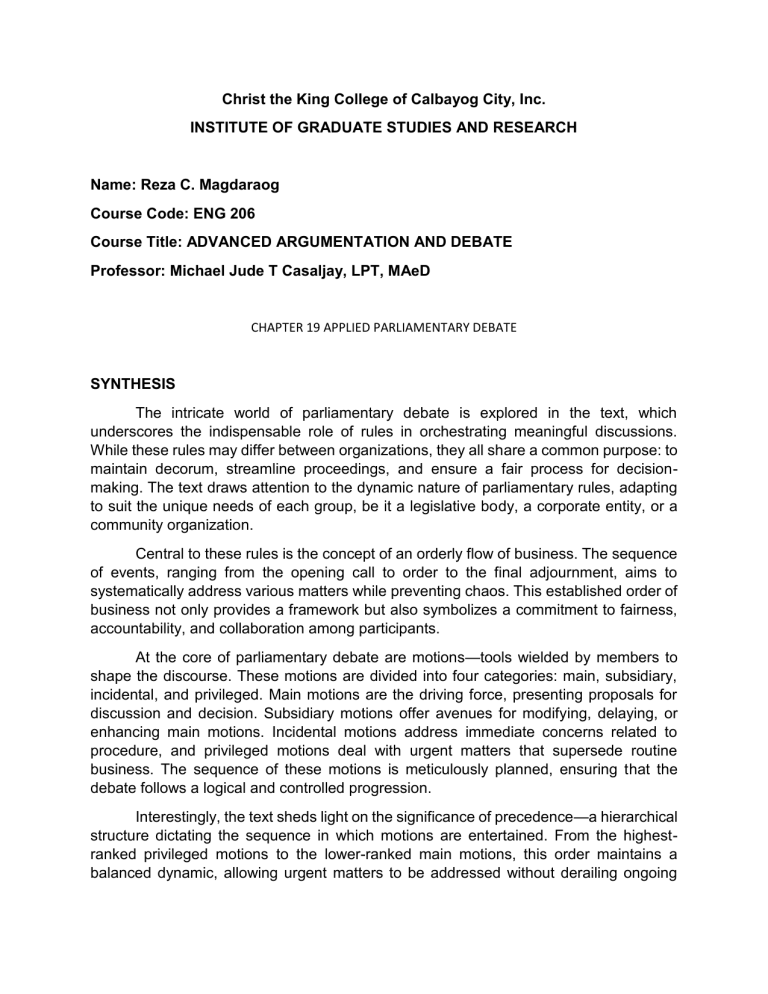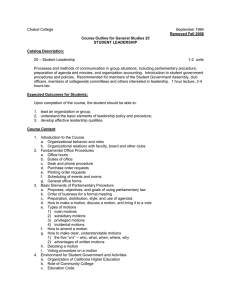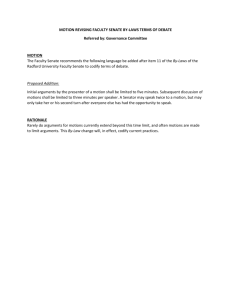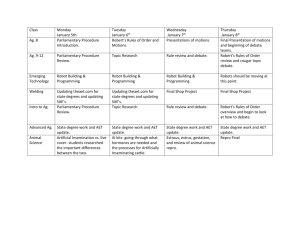Parliamentary Debate: Synthesis & Analysis | Advanced Argumentation
advertisement

Christ the King College of Calbayog City, Inc. INSTITUTE OF GRADUATE STUDIES AND RESEARCH Name: Reza C. Magdaraog Course Code: ENG 206 Course Title: ADVANCED ARGUMENTATION AND DEBATE Professor: Michael Jude T Casaljay, LPT, MAeD CHAPTER 19 APPLIED PARLIAMENTARY DEBATE SYNTHESIS The intricate world of parliamentary debate is explored in the text, which underscores the indispensable role of rules in orchestrating meaningful discussions. While these rules may differ between organizations, they all share a common purpose: to maintain decorum, streamline proceedings, and ensure a fair process for decisionmaking. The text draws attention to the dynamic nature of parliamentary rules, adapting to suit the unique needs of each group, be it a legislative body, a corporate entity, or a community organization. Central to these rules is the concept of an orderly flow of business. The sequence of events, ranging from the opening call to order to the final adjournment, aims to systematically address various matters while preventing chaos. This established order of business not only provides a framework but also symbolizes a commitment to fairness, accountability, and collaboration among participants. At the core of parliamentary debate are motions—tools wielded by members to shape the discourse. These motions are divided into four categories: main, subsidiary, incidental, and privileged. Main motions are the driving force, presenting proposals for discussion and decision. Subsidiary motions offer avenues for modifying, delaying, or enhancing main motions. Incidental motions address immediate concerns related to procedure, and privileged motions deal with urgent matters that supersede routine business. The sequence of these motions is meticulously planned, ensuring that the debate follows a logical and controlled progression. Interestingly, the text sheds light on the significance of precedence—a hierarchical structure dictating the sequence in which motions are entertained. From the highestranked privileged motions to the lower-ranked main motions, this order maintains a balanced dynamic, allowing urgent matters to be addressed without derailing ongoing discussions. Privileged motions, for instance, possess a unique status due to their urgency, effectively interrupting the regular flow of debate to address pressing issues. Moreover, the concept of unanimous consent emerges as a practical mechanism for expediting matters of routine agreement. This feature reflects the flexibility of parliamentary debate, accommodating both formal discourse and efficient decisionmaking. By invoking unanimous consent, participants can streamline straightforward matters, highlighting the adaptability of parliamentary rules to expedite non-controversial issues. Overall, the text provides a comprehensive view of parliamentary debate as a structured, deliberate process that ensures fairness, participation, and effective decisionmaking. It emphasizes the pivotal role of rules in creating a level playing field for all participants, fostering collaboration, and ultimately empowering groups to reach wellconsidered conclusions. ANALYSIS The text delves into the intricacies of parliamentary debate, outlining the rules, purposes, and various types of motions that govern formal discussions within organizations. It emphasizes the necessity of these rules to maintain order, efficiency, and impartiality in debates. Derived from the parliamentary practices of British parliaments, the text acknowledges that the specific rules can vary between different groups, such as legislative bodies, social organizations, or corporations. However, it highlights several overarching goals that all well-constructed parliamentary rules seek to achieve. The primary objectives of parliamentary debate are enumerated. First, it ensures the systematic progression of business, addressing one matter at a time before moving to the next. Second, it guarantees decisions by mandating that every motion introduced must be acted upon, either through passage, defeat, or postponement. This latter aspect underscores the importance of parliamentary debate in facilitating decisive outcomes. Furthermore, the text underscores the importance of protecting both majority and minority rights. It stresses that the decisions of a sufficient number of members must prevail, safeguarding the will of the majority. Simultaneously, it bestows significant privileges upon the minority, allowing their voices to be heard and permitting the introduction of motions by as few as two members. Additionally, the concept of impartiality is central, as the rules apply equally to all members, ensuring equal rights to be heard and equal voting power. The sources of parliamentary debate rules are discussed, revealing that each organization customarily adopts its own set of rules from a combination of sources, including the organization's constitution, bylaws, standing rules, meeting agenda, or other stipulated sources. While complex rules are necessary for legislative bodies, smaller groups often rely on a set of commonly accepted practices that meet their specific needs. The text stresses that deviations from common practice should be sparingly used and carefully considered. The order of business is outlined, delineating the sequence in which activities are conducted during a meeting. This systematic approach ensures that each step of the meeting is organized and predictable, starting from the call to order and concluding with adjournment. The hierarchy of motions is presented, with various motions classified into different categories: main motions, subsidiary motions, incidental motions, and privileged motions. These categories are designed to aid in efficiently managing debates and discussions, providing members with structured options to handle different aspects of the main motion under consideration. In conclusion, the text provides a comprehensive overview of the foundations of parliamentary debate, emphasizing the necessity of rules to facilitate organized and effective discussions within various organizations. It underscores the balance between majority and minority rights, the importance of impartiality, and the role of structured motions in guiding debates to productive outcomes. REFLECTION The comprehensive exploration of parliamentary debate presented in the text underscores the critical role that rules and procedures play in orchestrating organized and effective discussions within various types of groups and organizations. These rules are not arbitrary constraints but are carefully designed to ensure that debates proceed in an orderly, efficient, and impartial manner. At the heart of parliamentary debate are the motions – tools that drive the conversation forward and allow for the expression of ideas, opinions, and decisions. Main motions, for instance, represent substantive proposals, ranging from simple actions to complex plans. They give shape to the intentions of members, enabling them to set forth their ideas for collective consideration. Subsidiary motions, on the other hand, serve as crucial instruments for refining and modifying these main motions. They empower participants to engage in a more nuanced discussion, facilitating the pursuit of a wellinformed and balanced decision. The structure and precedence of these motions emphasize a logical progression, guiding the debate toward informed resolutions. Incidental motions cater to unforeseen circumstances, allowing members to address issues that arise spontaneously during discussions. These motions are woven into the fabric of the debate, enhancing its flexibility and adaptability. Privileged motions shine a light on matters of immediate importance or urgency, illustrating that even in the structured world of parliamentary procedure, there's room for addressing pressing matters promptly. These motions recognize the dynamic nature of decision-making and provide a mechanism for swift action when time is of the essence. The concept of unanimous consent highlights the practicality of flexibility within parliamentary debates. It recognizes that not all matters require extensive deliberation and allows for the expedited approval of routine or uncontroversial actions, effectively streamlining proceedings while maintaining a level of transparency and inclusivity. In essence, the text portrays parliamentary debate as a finely-tuned orchestration of discourse, where a diverse set of motions and rules harmoniously interact to ensure that the collective voice is heard, ideas are explored, decisions are reached, and the rights of both the majority and the minority are respected. This comprehensive framework offers organizations a balanced and systematic way to address matters of significance while upholding fundamental principles of democracy and fair representation.


